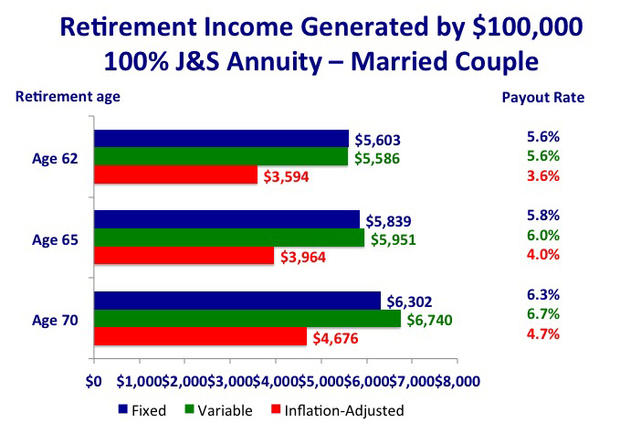Retirement income scorecard first quarter 2012: Immediate annuities
This post continues my retirement income scorecard for the first quarter of 2012, showing how much retirement income you can generate with $100,000 of retirement savings at the beginning of 2012.
This post examines immediate annuities, which are one of three ways to generate retirement income from your retirement savings. For background on these methods, you may want to review my recent post, My four favorite ways to generate retirement income.
Retirement income scorecard first quarter 2012: Interest and dividends
Retirement income scorecard first quarter 2012: Managed payouts
IRAs and 401k: 3 ways to generate retirement income
Method #3: Immediate annuities
With an immediate annuity, you give your retirement savings to an insurance company, and they promise to pay you a monthly retirement income for the rest of your life, no matter how long you live. You can continue the income flow for your spouse or partner after you die by using a joint and survivor annuity.
The retirement income generated from this method will vary depending on the type of annuity you purchase, and will also be affected by your age, sex, and marital status. To provide more of an across-the-board look at this method, I've shown the results for fixed annuities, variable annuities, and inflation-adjusted annuities. For fixed and inflation-adjusted annuities, I used rates from Vanguard's Annuity Access service. For variable annuities, I used rates from Vanguard's variable annuity offered with American General Life Insurance Company, with an assumed investment return (AIR) of 3.5 percent.
Shown below are the annual incomes generated for a single man, a single woman, and a married couple at three different ages. I've include the annual payout rates for the purpose of comparing to other methods of generating retirement income. These payout rates are not to be confused with investment rates of returns.
If you compare the retirement income amounts generated by the three methods I've described in this and the two previous posts, you'll see a wide range of results, depending on the method you use and your circumstances. In particular, you'll see that immediate annuities generally provide more retirement income than managed payouts. And with annuities, you're guaranteed a monthly check for the rest of your life, no matter how long you live. With managed payouts, the intent is that you won't outlive your money, but that's not guaranteed.
The big tradeoff with immediate annuities is that you generally give irrevocable control of your savings over to the insurance company, while with managed payouts you have the flexibility to tap into your savings. And with annuities, there's no money left for a legacy after you and your beneficiary die; with managed payouts, you can leave a legacy with any money left in your accounts when you die.
Please note that the incomes shown above are pre-tax amounts. Federal and state income taxes will have a significant effect on your after-tax income and should be taken into account. The income taxes you pay will vary depending on whether your annuity was purchased with pre-tax investments in traditional IRA or 401(k) accounts, or with after-tax investments.
When it comes to generating retirement income that will last the rest of your life, there's no single right answer that fits everybody. Your answer depends on your goals and circumstances. You may even want to split your retirement savings and use more than one method to generate retirement income to achieve the advantages of each method.
Because only you know which method or combination of methods might work best for you, you should take the time to learn as much as you can about the various methods. You'll thank yourself when you reach your 80s and 90s and your retirement income keeps chugging along.



